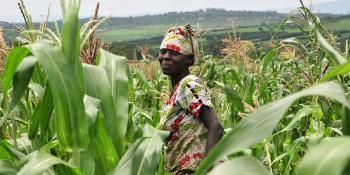Investigating the Effect of Climate Variability Maize Yield in Rwanda
The knowledge of climate variability is essential for successful agriculture, especial by rain fed crops. The goal of this research was to investigate the effect of climate variability and change on maize yield in Rwanda. Fifteen weather stations across the country were used and with regard to rainfall and temperature, the intra-seasonal climate variability were determined through analysis of various characteristics, including start and end dates of the season, length of the season, rain days, total seasonal rainfall, maximum temperature, minimum temperature, temperature range and growing degree days. The procedure of determining rainfall characteristics was carried out in Instat Plus statistical package Version 3.36 at station level. Early onset was identified in the Southwestern region during MAM season and northwestern regional during SOND. Cessation occurred over northeastern region during MAM season and northwestern region during SOND. More rainfall was received during MAM season. Eastern province and Central region of the country were very dry compared to other locations in the country. Highest temperatures were recorded in Nyagatare (Eastern Province) and Mageragere (Central region) with 27.00C and 26.40C respectively. Lowest temperatures were recorded at Busogo (Northern Province) with 20.50C and 22.90C at Gikongoro (Southern region). Temperature characteristics (maximum temperature, minimum temperature, temperature range and Growing Degree Days) showed negative relationships with maize yield, which implied that an increment in temperature resulted in a reduction in maize yield and a reduction in temperature resulted in increasing maize yields. Whereas, rainfall characteristics (Cessation, season length, rainy days, total seasonal rainfall), showed a positive relationships with maize yield, implying that an increase in rainfall improved maize yield and a decrease in rainfall lead to poor maize yield. The results revealed that there is an increase in climate variability (rainfall, maximum and minimum temperature) in RCP8.5 compared to RCP4.5. Rainfall is projected to increase by 4.3% (98 mm) at Busogo, 2.8% (50 mm) at Gikongoro, 3.3% (36 mm) at Kawangire and 3.1% (41 mm) at Rubengera, while maximum temperature will increase by 1.7% (0.4 0C), 1.6% (0.4 0C), 1.5% (0.4 0C) and 1.2% (0.3 0C) at Busogo, Gikongoro, Kawangire and Rubengera respectively. The minimum temperature also, will increase by 1.4% (0.2 0C) at Busogo, 1.4% (0.2 0C) at Gikongoro, 1.9% (0.3 0C) at Kawangire and 2.0% (0.3 0C) at Rubengera. From the future climate data, AqauaCrop model was used to simulate maize yield from 2021 to 2049. The results revealed that Rwanda’s agriculture, season A (September – January), maize yield will decrease by 8.1% (205kg/ha) at Busogo, 1.6% (28kg/ha) at Kawangire and 1.2% (23kg/ha) at Rubengera, and an increase in maize yield was projected at Gikongoro of 0.3% (5kg/ha) under RCP8.5.
Citation
Murenzi H. 2019. Investigating the effect of climate variability and change on maize yield in Rwanda. M.Sc. dissertation, Department of Meteorology, School of Physical Sciences, University of Nairobi.
